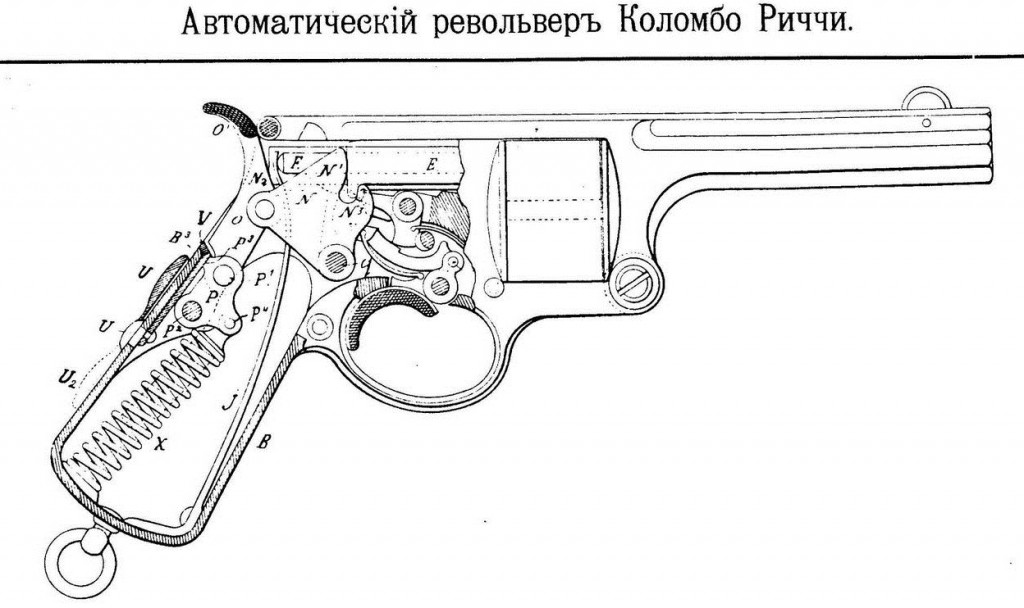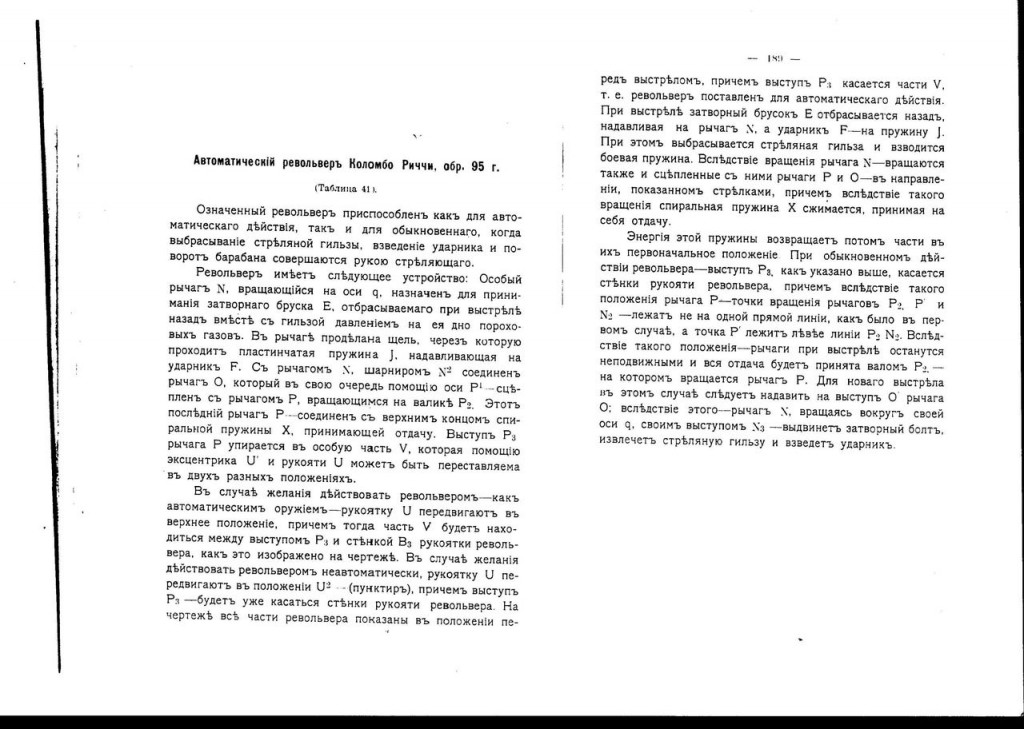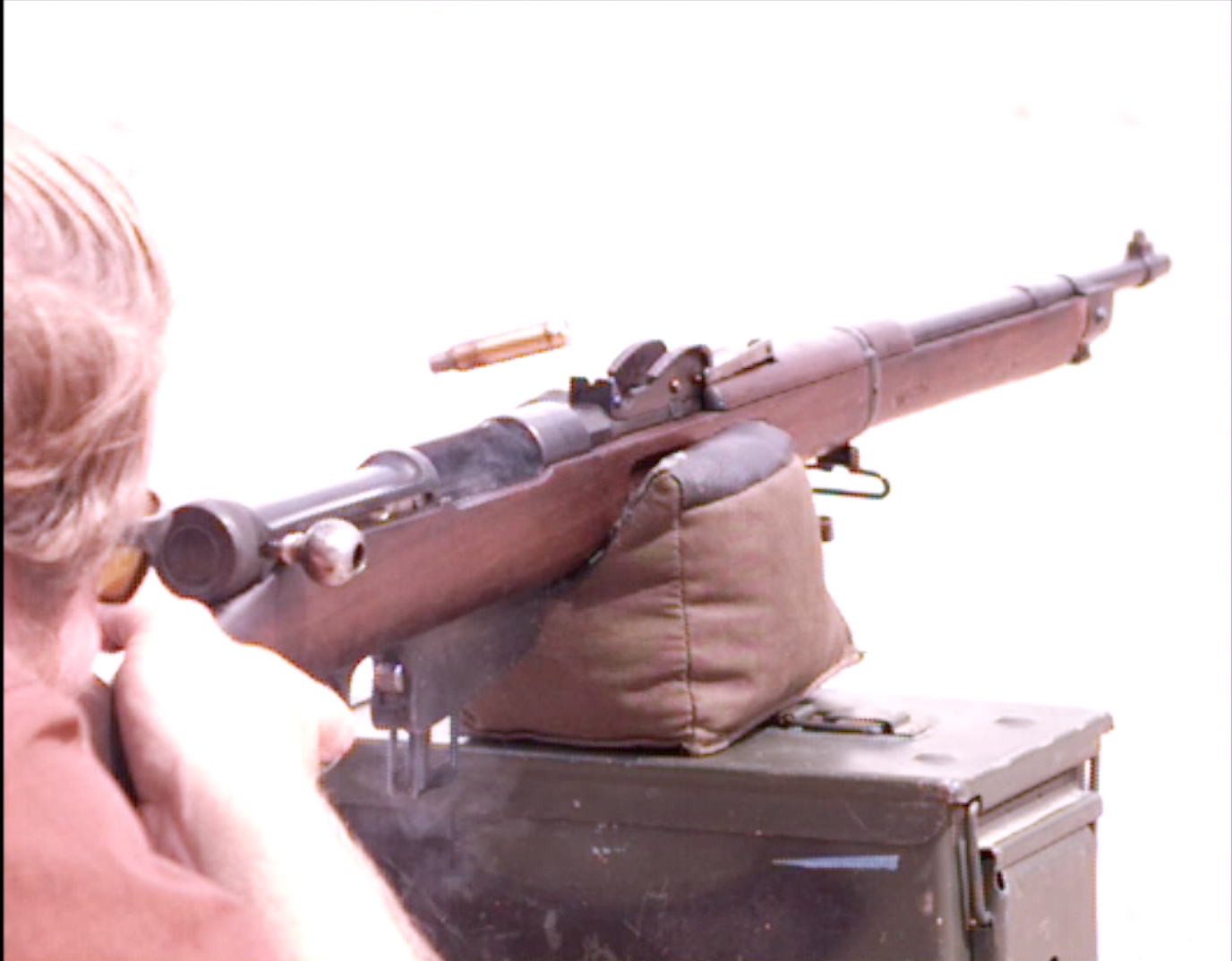The Colombo-Ricci is (was) an automatic revolver reportedly designed in Italy around 1910, and chambered for the standard 10.4mm Italian revolver cartridge. Very little information is available on the gun, but it seems reasonable to suspect that it was developed to compete for an Italian Army service handgun contract, as trials were going on through the first decade of the 1900s (which eventually led to the adoption of the 1910 Glisenti).

The Colombo-Ricci is distinct from other self-cocking revolvers because it actually ejected an empty case with each shot, and also had a selectable fire control system to allow either manual or automatic operation.
The diagram above shows the internal mechanism, and we can see how the automatic operation would have worked. The diagram was printed in a Russian book, and out friend Hrachya has thoughtfully translated the text into English, which is included in full below (along with the original Russian, for folks who can read it). Basically, the gun has 4 major operating components and two springs. The leaf spring J powers the striker to actually fire cartridges, and coil spring X is the recoil spring for the automatic system. The major parts are the bolt (E), cocking lever (O – it looks like a hammer spur, but does not actually function as a hammer), primary lever (N), and secondary lever (P). Upon firing, the bolt is thrown backwards, which pushes on the primary lever N, which in turn pushes on the cocking lever. The cocking lever is connected to the frame via the secondary lever, so that the cocking lever going backward forces the secondary lever to rotate on a pivot, and this motion is resisted by the mainspring. That spring resistance (along with a lesser amount of spring resistance from the leaf striker spring) is what controls the speed of the bolt (this is a simple blowback system).
In order to switch to manual firing, a lever on the backstrap of the grip is rotated 180 degrees (upward for automatic; downward for manual). What this does is change the pivot geometry of the secondary lever such that it is effectively locked, and the bolt cannot move backward upon firing. Think of this as a toggle or knee joint, and imagine a straight line from N2 to P2. When pivot point P is behind that line, the force of firing pushes the secondary lever backward into the frame, preventing it from moving. When P is in front of the line, the force of firing breaks the joint open, allowing it to cycle and compression the coil mainspring. What the selector lever on the grip does is move the position of P just far enough forward and backward to effect that change in geometry.
A clever detail of the mechanism is the specific location of the pin connection the primary lever (N) and cocking lever (O). It is placed such that when recoil from firing pushes the bolt back, the vector of the force exerted on the cocking lever will not move the cocking lever when in manual firing mode. However, if the cocking spur is pulled manually, the force will operate the mechanism and cycle the bolt. Compare the location of the cocking spur to that line from N2 to P2 – it is behind the line, which means that exerting force on it will operate the mechanism regardless of the geometry change induced by the firing mode selector lever. Very clever!
Unfortunately, there seems to be no record of the Colombo-Ricci actually being manufactured, and I have not seen any reference to even a single prototype surviving. It certainly would be an interesting project for a mechanically-minded gunsmith!

English translation, courtesy of Hrachya:
Colombo Ricci Automatic Revolver, mod.95y.
The revolver is adapted for both automatic and conventional (when ejection, cocking and cylinder rotation are managed by shooters head) actions.
The revolver has following construction: During firing process special lever N, which rotates on axis q, is designed to receive the bolt bar E, which is thrown back along with cartridge case by the pressure of gases on case head. The lever has a hole inside it, through which leave spring J passes and applies pressure on striker F. Lever N is attached to lever O by hinge N². Lever O uses axis P¹ to connect to lever P1, which rotates on roller P2. Lever P is also connected to the upper end of spiral spring X, which receives the recoil energy. Lever P’s lug P3 rests on the special part V, which can be set to one of two positions by cam U’ and selector U. If automatic fire is needed, then selector U must be turned to upper positions. At that moment part V will be between lug P3 and grip wall B3 as shown on drawing. If non automatic action is needed, then selector U must be turned to position U². At that position lug P3 touches the grip wall of revolver.
On the drawing all parts are on ready-to-fire position and lug P3 touches part V, meaning that revolver is set for automatic fire. When shot is made, bolt bar E travels backwards, presses on lever N , and striker F presses on spring J. At same time fired case is being ejected and mainspring – cocked. As lever N rotates it forces lever P and lever O (which are attached together) also to rotate. Direction of rotation is shown on drawing by arrows. As a result of this rotation spiral spring X compresses receiving the recoil force. The energy of expanding (back) spring drives all the parts to their initial positions.
During usual (non automatic) action of revolver, lug P3 touches grip wall and position of lever P makes pivot points of levers P2, P’ and N2 misaligned (P’ lies left to P2 N2 line). At this position levers will stay still during firing and recoil energy will be received by P2 roller (which is the rotation axis for lever P). For next shot tail O’ of lever O must be pulled. As a result lever N will rotate on it’s axis q and will pull the bolt by it’s N3 lug extracting the case and cocking the striker.



The two springs resisting the bolt movement must provide a fair amount of force, because the Modello 99 smokeless loading of the 10.4mm Italian Ordnance was fairly potent. The still available Fiocchi loading propels a 177 grain bullet at 820 fps for 264 ft-lbf of energy. This loading is almost certainly based on the Mod. 99 military loading. That’s quite a lot especially since the mass of the bolt can’t be very high.
Come to think of it some more: since it’s a revolver, some pressure is vented through the cylinder gap in any case. Maybe that helps in keeping the bolt forward long enough.
The trigger on drawing looks strange to me, in most revolvers when you squeeze trigger the movement is parallel or near parallel to axis of bore, here it is more near to perpendicular – the trigger on drawing is squeezed or released? Even if it is squeezed the trigger looks suspicious for me. Do you have any suggestion why the trigger looks as looks?
Would be that grip of angle comfortable for shooter? I have impression that it was designed by someone that don’t know much about ergonomics of firearms. What you think about ergonomics of this revolver?
The ergonomics could be okay for traditional single handed shooting style. For modern two-handed stances probably quite uncomfortable.
I suspect that this design maybe patent in Italian Patent Office, but I don’t know Italian and hope that somebody of you can check if it was patented. Assuming that Colombo or Ricci is name of inventor it shouldn’t be hard to find Italian patent if it exists.
It was really exciting to do the translatation and study this gun … it is an ingenious design indeed!
Thankyou for the translation
I’m trying to figure out where it ejects, and I’m suspecting it works sort of like a Webley equipped with Silver & Fletcher’s patent extraction system (British Patent #16,078, 1884). (It doesn’t seem to be anywhere online, but it’s on p. 302 of The Handgun by Geoffrey Boothroyd.)
One drawback of such a system is that the cartridge ejection is necessarily straight backward, parallel to the chamber and bore axis. This seems well designed to hit the shooter right in the eye if the case is projected with enough force to ensure it clears the chamber.
Other than the internal mechanism, the drawing looks suspiciously like a Webley-type topbreak revolver, or possibly a Tranter or Kynoch. Please note that one subvariant of those, the Dimancea, was designed not by an Italian as you might expect from the name, but by a Rumanian. Such revolvers were made by Kynoch for the Rumanian government under contract.
Query; Is “Columbo-Ricci” the name of two Italian designers, or were one or both actually Rumanian? And if so, might this not be an experimental design based on the Kynoch pattern?
If so, it could explain why its existence (even as only a proposal) is apparently only found in Russian references.
Just a guess.
cheers
eon
Well, I did find a Webley with the Silver & Fletcher extraction setup. Predictably, it was at RIA:
http://www.rockislandauction.com/viewitem/aid/63/lid/145
The hammer on this particular one apparently also functions as a safety, operated much like that on a Model 98 Mauser bolt-action rifle;
http://www.rockislandauction.com/photos/63/p_standard/NSM240-R-F2C-H.jpg
And here, I thought the whole point of the DA revolver was not to need a safety. Silly me.:-/
cheers
eon
Early DA revolvers (Webley RIC included) did not have hammer rebound. It was introduced earky-1870s, being originally Pryse (of Webley-Pryse fame) patent.
Before that there were half-cock notches (iffy, could be broken off) and Gasser (and Francotte) used two pins blocking action that were engaged when hammer was put at half-cock. Pins were withdrawn only when trigger was fully pressed. That one was pretty safe, and also could be fired in DA mode from half-cock position. What Pryse did was automatize working of that one that it is automatically engaged when trigger is released.
European revolvers started using rebounding hammer since early 1870s and older style DA w/o rebounding hammer practically died out by late 1880s.
US companies were much slower to introduce it (as were with DA), only by mid 1880s were first US made DA revolvers with rebounding hammer made and guns w/o rebounding hammer were made well into early 20th century.
Revolver as we know it today is child of European inventors even if it was US companies that were first to apply those patents – rebounding hammer, side ejecting cylinder, lockwork etc. IIRC only transfer bar is “US” invention (Iver Johnson) even if it bears quite a resemblance to Francotte patent for “safe revolver hammer”.
Unlikely. Both Colombo and Ricci are Italian names. Italian and Romanian are of course both Romance languages, so a high degree of similarity of vocabulary exists, but Colombo and Ricci are not Romanian names.
Hi
“Ricci” is surname, “Colombo” is name; he was an italian engeener worked about weapons and ammo.
What was the title of the russian book and where can i download it ?
You are welcome, Juver. Many thanks to Ian for posting!
I downloaded these scans from а russian forum a while ago (guns.ru). Unfortunately couldn’t find the book it was scanned from.
Thankyou Hrachya for the translation
I would not speak, for this weapon, of a “simple blowback system”. It’s surely a blowback system, but, between the cocking lever, primary and secondary lever, there seems to be a significant mechanical leverage involved. This revolver seems to lie somewere between the lever delayed and toggle delayed blowback systems.
Furthermore, otherwise, the rate of fire in full auto would have been too high.
You have a good point, considering the number of pivots and levers involved. The one is unusual enough that the standard action descriptions don’t really apply well.
Haven’t seen any describtion about how the cylinder rotates. But appearently, this is another handgun like Webley-Fosbery getting use of recoil to rotate the bulky magazine. Those kind of revolvers have a sole advantage of a cocked, ready to fire impact elements with a short trigger travel types without the real bonus of mechanicaly rotating cylinders getting a fresh round with every trigger pull. Then, what would be the advantage of that very little amount of cartridge capacity in a bulky cylinder of high volume against to usual lined of flat types. Practicaly a useless approach.
Another autorevolver, makes you wonder how many more are in the wood work…
speaking of which here’s a gas-powered design I was pointed to when trying to find out info on the revolving magazine semi-auto prototype that was featured on the sight last year, seems reasonably elegant
It’s image six: https://www.google.st/patents/US515064?dq=ininventor:%22The+Odor+Unge%22&hl=en&sa=X&ei=ArTNVPaxHsKF8gWzuICQCg&ved=0CB0Q6AEwAA
C. Ricci was awarded British Patent 16,272 on 27th August 1894. The illustration of the revolver is different i.e. The main spring is a V shape, also the trigger guard is hinged at the front and connects with the V spring. The trigger is shown in both positions, the illustration at the start of this article is in the fired position. The patent also covered a self ejecting rifle which was then reloaded by hand with a single round.
A year earlier he had been awarded British Patent for an automatic rifle, 7,003 dated 5th April 1893 which had a six round rotary spool magazine.